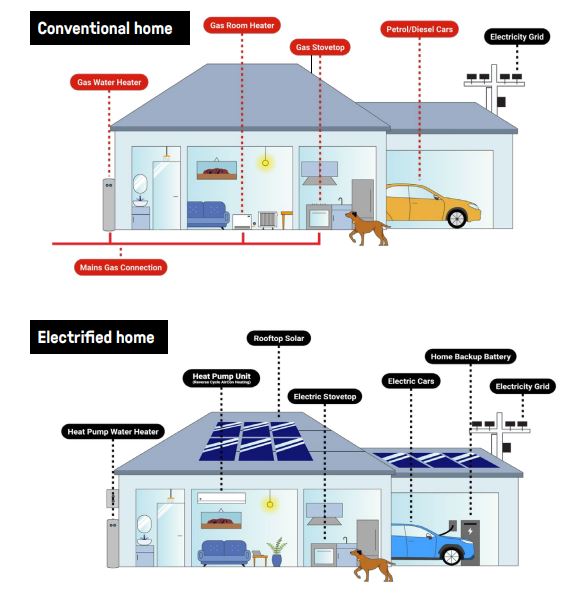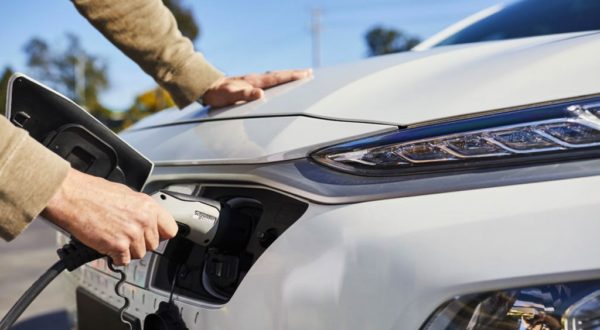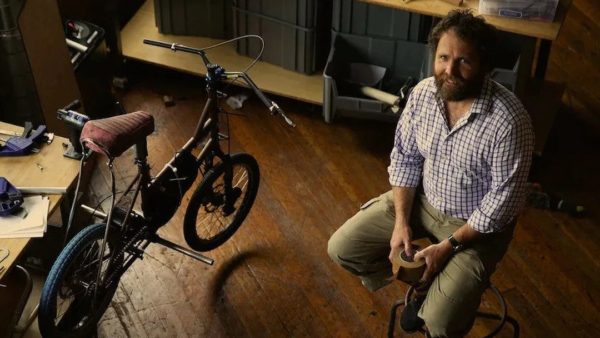Independent thinktank Rewiring Australia has released modelling which shows the solar-backed electrification of homes and vehicles in the Queensland capital of Brisbane using technology that is almost entirely off-the-shelf and available today would save the average household $4,700 a year in energy bills and vehicle costs.
Rewiring Australia, the work of Australian-American entrepreneur, scientist and energy analyst Dr Saul Griffith, has released modelling that outlines how households and communities can financially benefit from replacing fossil-fuelled devices with solar panels, batteries, heat pumps, induction stoves, electric vehicles (EVs) and household and community batteries.
The modelling, set to be publicly released by Griffith during an online webinar tonight, shows the full electrification of households across greater Brisbane by 2030 would save the average household $4,700 per year in energy and vehicle costs, totalling $3.9 billion across all households.
Rewiring Australia said in addition to the cost savings, the economic flow-on effects across the region could spark the indirect creation of up to 24,100 new jobs with an estimated $200 million to be spent upgrading homes, installing zero emission appliances, solar and EV chargers.

While acknowledging the inevitable upfront costs, Rewiring Australia founder and chief scientist Griffith said households making the jump to solar, storage and EVs would provide a massive economic boost to greater Brisbane.
“Our research shows that Australia can lead the world by electrifying our homes and vehicles and powering them with renewable energy,” he said.
“If we make the necessary investment to seize the future it will look like more jobs for tradies, more money spent in local shops, cleaner air and healthier people.
“At the moment, $3.3 billion is being drained from the greater Brisbane economy and winding up in the pocket of those who peddle fossil fuels. If we electrify and decarbonise we keep that money in the local community and make the world cleaner and safer.”
Rewiring Australia said the first step in the electrification process would be to install solar, or “supersize the existing system” while it is “vital to have a smart inverter and upgrade the switchboard to manage how the house exports and imports to the grid”.

Image: ARENA
The organisation said the biggest financial outlay would be to replace petrol and diesel cars with EVs and use the batteries as part of the household energy system. Gas-fuelled devices would also be replaced. Rewiring Australia said this would deliver immediate savings.
“An electric car costs about 6 cents per kilometre to drive if charged from the grid, compared to a petrol car which costs about 12 cents per km (when petrol is at $1.43/L). Charging an electric car with rooftop solar reduces this even further, to about 1 cent a km, over 10 times less than a petrol car,” the organisation said.
“Heating the water for a shower with a gas-fuelled water heater costs about 89 cents with standard gas prices (2019). An electric heat pump water heater costs just 21 cents to provide the same hot shower using grid electricity. Using rooftop solar, that shower costs just 5 cents, over 10 times less than a gas shower.”
Rewiring Australia said the savings modelled for electrification take into account the upfront costs of purchase and assume that they are financed over the lifetime of the asset.
Griffith said the benefits of the electrification process are amplified when entire suburbs, communities and regions electrify their homes.
“When entire communities and cities upgrade and electrify, the benefits will be amplified and shared,” he said. “Less money will be sent out of the community and offshore from Australia. Billions of dollars can be retained in local communities and thousands of additional local jobs generated.”
Griffith said the technology to decarbonise and electrify households exists today and “the more that consumers buy electric vehicles, solar, batteries and electric appliances, the cheaper and better they get”.

Image: Solar Schools
Rewiring Australia said the initial modelling is based on the potential uptake across the southeast Queensland federal electorates of Brisbane, Longman, and Griffith, but the program is also planning to analyse other seats across the country.
The release of the modelling comes after The Greens proposed the electrification an entire Australian town and a suburb in a major city of the party’s climate and energy policy in the lead up to the federal election later this month.
Party leader Adam Bandt said the pilot project, to be enabled by a $235 million fund, would seek to show that by 2025 it will be cost effective for households to be completely electric, largely powered by rooftop and community solar and batteries.
“This hasn’t been achieved anywhere in the world,” he said. “It’s time to get off the gas, get batteries in our homes, and solar on the roof. We will show this works at scale, creating jobs and powering up a community.”
A study released last year by Rewiring Australia found a $12 billion investment would retrofit 11 million Australian households for full electrification by 2030 leading to national savings of more than $40 billion and removing one-third of domestic carbon emissions.
Griifith said the full electrification of Brisbane households would reduce the region’s emissions by 42.4%.
“Electrification attacks the three huge national problems – climate heating, cost of living and national security,” he said.
This content is protected by copyright and may not be reused. If you want to cooperate with us and would like to reuse some of our content, please contact: editors@pv-magazine.com.









presenting the household savings projected by the modelling without the capital cost required to achieve them is telling half the story and misleading for many readers. How many households could afford it?
Hi Ross, thanks for your comment! I was at an event with Saul Griffith last Thursday and he spoke at length about this because you’re completely correct: electrification has a higher upfront cost (though this won’t remain as high as those appliances, cars etc become more popular. It is nonetheless the case today though). Firstly, here Griffith says its pretty unfeasible that houses are going to switch all their gadgets for renewable or electrified versions at once, rather the conversation should be around, say, when you hot water system comes to the end of its life, that’s when it should be replaced with a solar version. So then the calculation becomes not forking out $4k for a solar system, but rather paying an additional $2k on top of what you would have already had to pay for a new hot water system. Perhaps more importantly than that though, he said, is green financing and government subsidies. The onus shouldn’t sit solely on households to fork out for this technology but rather that governments should help with some of that upfront cost which will ultimately drive the cost curve down and make subsidisation no longer necessary. This is why (I suspect) Rewiring Australia is pushing out so much modelling ahead of the election, with Griffith saying at the event it has been telling that primarily been the ‘teal’ Independent candidates which have taken this modelling on, though the Greens have also run with it strongly (note, Adam Bandt is proposing to electrify a city suburb from a public fund as well a using the Clean Energy Finance Corporation – another fund Griffith proposed Australia should draw more from seeing as large-scale solar and wind no longer really need public subsidisation). I hope this in part answers your question, Ross. Cheers
So you say that showering during the day when most people are either at work or school will not work as for charing your ev during the day at home from solar again when most people work again will not work.
Large errors in the modelling already as the cost just from gas hot water to instant electric is a minimum $3500 per house and that does not include the electric cooker.